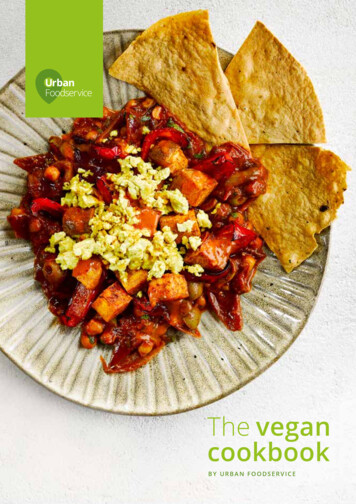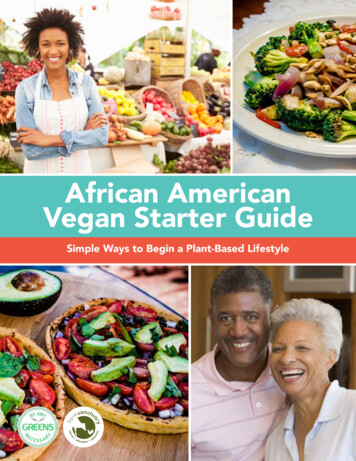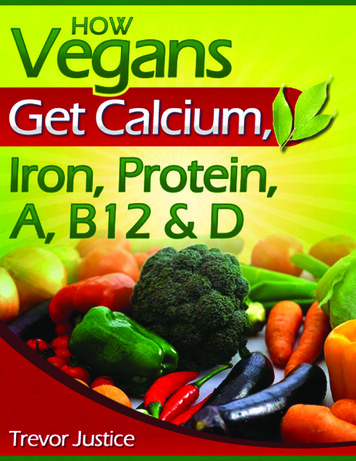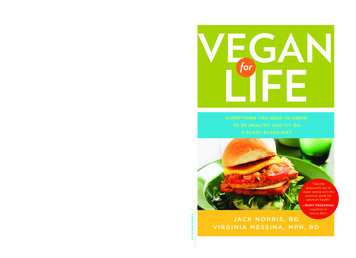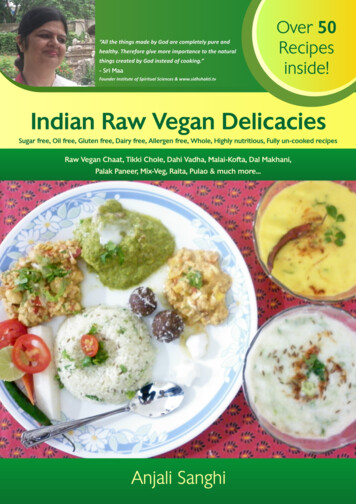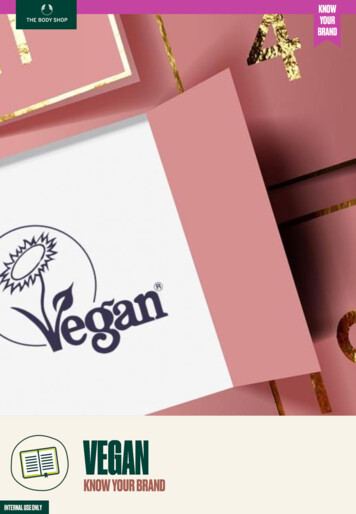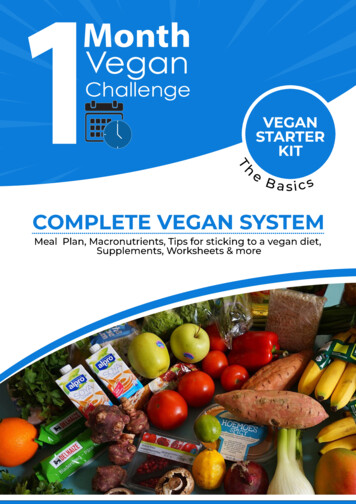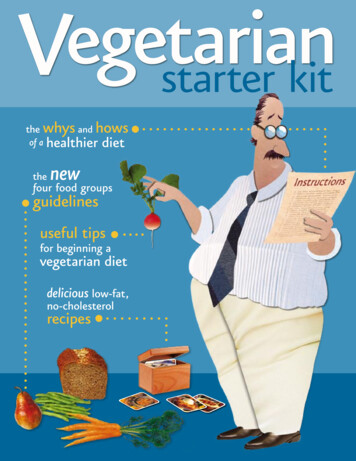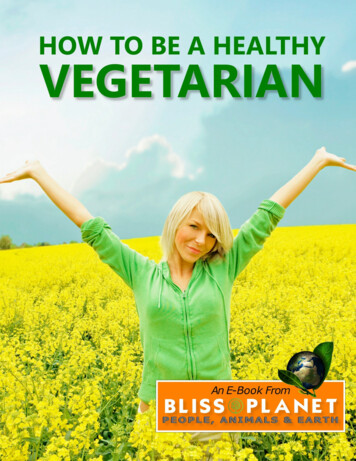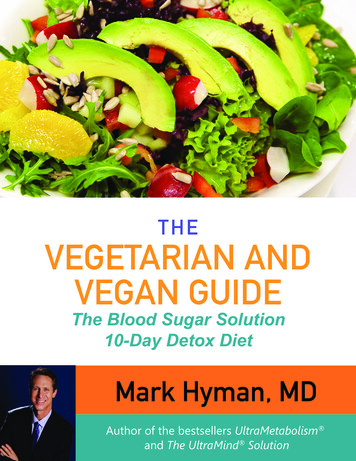
Transcription
THeVEGETARIAN ANDVEGAN GUIDEThe Blood Sugar Solution10-Day Detox DietMark Hyman, MDAuthor of the bestsellers UltraMetabolism and The UltraMind Solution
IntroductionEating a plant-based diet has consistently been shown to be one of the most effective ways to obtain excellent health and prevent genes from turning on chronicdisease. While a diet with moderate portions of lean, naturally-fed, and humanelyraised poultry, wild meat, farm fresh omega-3 eggs and wild caught fish are animportant part of sustaining success on The Blood Sugar Solution 10-Day DetoxDiet, vegans and vegetarians can reap the benefits, as well!Clean, “green”, and lean animal protein is important to balancing blood sugarbecause it provides a non-starchy source of protein and this is why many of myrecipes contain moderate portions of these foods.Carbohydrates, even healthy ones such as beans, lentils, squash, and yams,may spike your blood sugar and put you at risk for insulin resistance. Vegetariansources of protein usually rely on beans and legumes and can be quite carbohydrate-rich.Add in other carbohydrates such as fruit, squash, or whole grains to your plantbased meal and you have the makings for a high-glycemic meal. Many vegetarians often wonder why they have diabesity when they eat so “healthy.” Remember, low-glycemic meals are the only proven way to prevent and reversediabesity. Is there also a way to honor your vegetarian or vegan lifestyle and, ifso, how do you create low-glycemic meals without eating animal protein?The goal for you, if animal protein is not part of your diet, is to ensure a variety ofvegetables, a balance of diverse protein sources, and moderate intake of complex carbohydrates. While this can pose a challenge for many people, eating aplant-based diet suitable for the targeted outcomes of The Blood Sugar Solution10-Day Detox Diet is possible and, with some clear guidance, can be just as successful.In the following guide, I will share with you the secret to making a vegan andvegetarian diet that is the perfect match for your philosophical, spiritual, religious,palate, and culinary preferences. I hope you are ready to learn, experiment, andget healthy because what you are about to read can be life-changing!INTRODUCTION2
General Nutrition Guidelines:All Calories Are Not Created Equal. Focus On Food Quality.Food is Information: Food literally talks to your genes and controls gene expression, hormones, andmetabolism. What you eat has the potential to determine if you will get sick or gain weight. Eating asugar cookie versus a small handful of raw almonds can turn on disease-promoting genes. Choosea nutrient-dense meal where quality calories work for your health goal!Keep Grain Portion Size Small: Eventually you may follow the basic track if you transition to TheBlood Sugar Solution. On the Basic track, you may include moderate whole grains such as quinoa,amaranth, or black rice, which contain moderate amounts of protein. In general, balancing a wholegrain with a legume, such as rice and beans, can create a complete protein.No Grain Option: If you are on the Super Advanced or the Advanced tracks, you will omit ALL grainsfor the duration of the program. See chapter 19 of The Blood Sugar Solution and Appendix A of thisreport for more examples of portion sizes for when the 6 weeks are over.Focus on the Glycemic Load, not the Calories: How quickly your meal raises your blood sugarand spikes insulin is the essential piece of information you need to understand to sustain healthyweight and wellness. It is MORE important than mastering calories. Foods with fiber, protein, andanti-inflammatory fats mitigate the negative effects that blood sugar and insulin spikes have on yoursystem. Curious about what this looks like? My nutritionally balanced and complete meal plan provides a terrific example of how to create low-glycemic load meals.What About Protein? If you are trying to remain vegetarian or vegan, you can swap animal proteinsfor whole, organic, Non-GMO soy products such as tofu or tempeh once or twice a day. A servingsize of traditional soy foods is a quarter pound or about 3 ounces. This does NOT include soy proteinisolates or concentrates found in alternative “meats” such as soy burgers, meatless “chicken,” soyprotein found in protein bars, or even hidden in restaurant meat as filler!Go Nuts: Add nuts and seeds to your diet as a source of protein and good fats including almonds,walnuts, pecans, macadamia nuts, pine nuts, pumpkin seeds, sesame seeds, chia seeds, and hempseeds.Eat Eggs: Eggs are a wonderful source of protein (for vegetarians not vegans) and if you choosewhole omega-3 eggs you will be getting good fats with great protein.Start Sprouting: You can sprout beans, seeds, and even grains to increase their nutritional valueand ease of digestion.Always Combine a Carbohydrate with Fiber, Protein or Anti-Inflammatory Fats: Never carb italone! Being a vegetarian, and especially vegan, makes it challenging to reduce the total glycemicload because, besides soy, there aren’t many substantial complete proteins for you to fill up on. Legumes are usually the main source of protein. Beans and lentils, while chock full of healthy fiber andnutrients, are still a great source of carbohydrates. It is important to adhere to serving sizes of theselegumes in order to achieve success when it is time for you to transition to The Blood Sugar Solution.Please see Appendix A for appropriate serving sizes of legumes.GUIDELINES3
4 Principles for a Healthy Planet and a Healthy Vegetarian or Vegan You1. Eat REAL food. Shop the perimeter of your market for nutrient-dense whole foods.2. Clean up your diet. Choose organic, Non-GMO whole soy products and completely avoidfranken-soy products typically made from Monsanto’s Roundup soybeans.3. Go organic. Choose as much organic food as your budget allows. See the top offenders atwww.ewg.org .4. Stay local. Farmers Markets and Community Supported Agricultural stores (CSA’s) are greatopportunities to procure high-quality fresh food.Choose SLOW Carbs, Not LOW CarbsGreen Carbs: Eat Freely Fill your plate with 50 percent slow-burning, low-GL (glycemic load) vegetables such as kale,broccoli, lettuce, radish, arugula, celery, mushrooms, snap peas, bok choy, asparagus, bell pepper, watercress, cauliflower, Brussels sprouts, tomatoes, dandelion greens, hearts of palm, cucumber, etc. Seaweeds - Sea vegetables supply important sources of minerals such as iodine, calcium, andiron which tend to be difficult to access from land plants in the proper form to be metabolized andused by the body. They help restore the body back to balance by decreasing acidity, boosting detoxification, and even promoting weight loss. Sea veggies are wonderful additions to your mealsand add flavor as well as improve digestion of certain foods such as beans. For more informationon how to get started using these superfoods, check out our easy guide to understanding seavegetables in Appendix B.Yellow Carbs: Eat in ModerationWhole Grains Avoid if on the Super Advanced or Advanced Plan Brown and black rice, quinoa, amaranth, teff, and buckwheat.Legumes Avoid if on The Super Advanced Plan Lentils (red, green and yellow), black beans, kidney beans, adzuki beans, mung beans, chickpeas, pinto beans, black-eyed peas, fava beans, etc.Dark Berries Limit to ½ cup if on the Super Advanced or Advanced Plan Blackberries, raspberries, strawberries, and wild blueberries.Stone Fruit Avoid if on the Super Advanced or Advanced Plan Nectarines, plums, peaches, and apricots.Apples and Pears Avoid if on the Super Advanced or Advanced PlanFiber Aim for 30-50g daily. Studies show that vegetarian and vegan diets containing at least 50g ofnutrient-dense fiber can be effective for reversing the damage from diabetes and insulin resistance.GUIDELINES4
Red Carbs: Eat LIMITED AmountsStarchy, High-Glycemic Cooked Vegetables Avoid if on the Super Advanced or Advanced Plan Sweet potato, yam, winter squash, parsnip, and pumpkin.High-Sugar Fruits Avoid if on the Super Advanced or Advanced Plan Grapes, bananas, dried fruit (raisins, dates, etc.), and all fruit juice or fruit packed in juice.Forbidden Carbs: Avoid COMPLETELY Processed Carbs Gluten-Containing Whole Grains (wheat, barley, rye, kamut, spelt, einkorn, and triticale) Dried Fruit Resistant StarchBoost phytonutrient intake by choosing foods with dark colors. See Appendix C for a list of phytonutrient rich foods.Fat Does NOT Make You Fat Get an oil change: Replace BAD fat with GOOD fat. Avoid products containing soy oil. Choose anti-inflammatory fats such as omega-3 and monounsaturated over trans andhydrogenated. Omega-3’s: Include 2 tablespoons of flax seed and 1 combined tablespoon of borageand flaxseed oil into your daily diet. Sprinkle hemp and chia seeds on salads. Top cookedor raw vegetables with coconut or almond yogurt. Monounsaturated Fats: Eat olives, olive oil, and avocado. Healthy Oil Choices: Extra virgin olive oil, walnut, and flax oil are great for salads. Sesame,grape seed, coconut, and sunflower oil are good for baking. Healthy Saturated Fat? Yes! Enjoy coconut butter and oil in place of butter.Eat High-Quality Protein for Blood Sugar and Insulin Balance and Hunger Control Beans or legumes such as chickpeas, kidney beans, and lentils are excellent sources of highfiber protein. However, avoid all beans and legumes if you are on The Super Advanced or Advanced Plan. Whole soy products. Choose Non-GMO and organic, avoid industrial over-processed soy likesoy junk food (just because it has soy doesn’t mean it’s healthy). Whole soy is an excellentsource of magnesium and iron which are often deficient in vegetarians and vegans with diabesity. Nuts and Seeds. Especially protein rich hemp seeds, and almonds. Omega-3 Eggs or Free-Range Eggs.GUIDELINES5
Whole–Food Protein Shakes. Hemp, pea, rice, or high-quality soy protein powder offer an efficient way to include substantial protein in your diet, especially in the morning.Pay Attention to Important Nutrients Often Lacking in Vegetarian and Vegan DietsPeople honoring a vegetarian or vegan diet need to consider a few essential nutrients when mealplanning, such as calcium, omega-3 fatty acids, vitamin B-12, vitamin D and iron. Below is a list ofthe nutrients vegetarian diets sometimes lack and the foods to eat so you get enough of them: Calcium - The good news is you DON’T need dairy to meet your calcium requirements if youare a smart consumer. Calcium is plentiful in dark, leafy, green vegetables (bok choy, cabbage,collards, kale, mustard greens, and chard), broccoli, Brussels sprouts, fortified tofu, fortified soyor almond milk, rice milk, or hemp milk. Omega-3 Fatty Acids - Choose walnuts, ground flaxseed or flaxseed oil, soybeans, chia seeds,or hemp seeds. Vitamin B-12 - Found ONLY in animal products and in lesser amounts, in fortified foods. If youare an ovo-vegetarian then omega 3 eggs are a good source of this vitamin. If you are vegan,non-dairy milk alternatives like soy and rice milk beverages will provide some B12, but not nearlyenough to meet daily requirements. To meet your needs while on The Blood Sugar Solution, Isuggest you take a high-quality supplement which includes at least 250 mcg of methylcobalamin such as the one listed here: Plan-Wellness-Essentials-Kit Vitamin D - While some foods contain vitamin D, I recommend everyone, regardless of dietarypreference, take a vitamin D supplement. Unless you live in Florida, or south of there, sun exposure will not be sufficient to help your body make its own vitamin D. I suggest everyone take atleast 1,000 IUs, or more, daily depending on blood levels. Iron - Iron-deficiency anemia is a serious issue in vegetarian diets. It also happens to be criticalin helping to restore a body from the effects of diabesity. Beans, lentils, fortified tofu, and cookedgreen vegetables are good sources. The key is to combine these iron-rich food sources with agood source of vitamin C such as lemon, tomatoes, broccoli, or even berries, such as strawberries, to increase absorption.GUIDELINES6
10 Blood Sugar Solution Approved High Iron Plant-Based FoodsSpirulina (1 teaspoon)Cooked soybeans (1/2 cup)Pumpkin seeds (1 tablespoon)Quinoa (1/2 cup)Walnuts (1/4 cup)Tomato paste (1/2 cup)White beans (1/2 cup)Cooked spinach (1/2 cup)Lentils (1/2 cup)Sulfate free dried peaches (3 halves)Blackstrap molasses (about 1 teaspoon)5 mg4.4 mg4.2 mg4 mg2.8 mg3.9 mg3.9 mg3.2 mg3 mg1.5 mg2 mgSource: ins/iron.htmlTips for Getting the Most Iron Out of Your Food: Eat iron-rich foods along with foods that contain vitamin C for optimal absorption. See table below for sources of vitamin C rich foods. Tea and coffee contain compounds, called polyphenols, which can bind with iron making it harder for our bodies to absorb. Calcium hinders the absorption of iron; avoid high-calcium foods for a half hour before or aftereating iron-rich foods. Cook in iron pots. The acid in foods seems to pull some of the iron out of cast-iron pots. Simmering acidic foods, such as tomato sauce, in an iron pot can increase the iron content more thanten-fold. Cooking foods containing other acids, such as vinegar, red wine, and lemon or limejuice, in an iron pot can also increase the iron content.Vitamin C Rich FoodsGuavaKaleRed bell pepperCantaloupeKiwiBroccoliOrangeKohlrabiGreen bell pepperSweet potatoGrapefruitTomatoesBrussels urce: ins/iron.htmlGUIDELINES7
Sample Meal Makeovers for Vegetarians Participating on the Super Advanced andAdvanced Track:BREAKFAST: Poached Eggs Over SpinachVegetarian: If lacto-ovo then enjoy as is!Vegan: Replace egg with either 3 ounces of tofu or chickpeas if you are on the Advanced or Basicplan. In Middle Eastern cuisine, chick pea tomato salad is very common. Why not try thinking outsideof the box and even experiment with other spices, such as sumac, to provide that exotic flare!Make it Quick and Easy: Try the Ultrashake made with either rice protein, fruit and nut, or, Dr. Hyman’s favorite, Whole Foods Smoothie.LUNCH: Walnut Pesto Chicken with White Bean SaladVegetarian: Replace chicken with 3 ounces of Non-GMO tempeh.Vegan: Replace chicken with 3 ounces of Non-GMO tempeh.Make it Quick and Easy: DIY Salad Bar. Choose from the following to create a quick and easy lunch:2 cups of ANY nonstarchy vegetable such as arugula, spinach, red leaf lettuce, broccoli, cauliflower,roasted Brussels sprouts, carrots, celery, mushrooms, sugar snap peas, bell peppers, onion, sprouts,etc. Top off with 3 ounces of pan seared tofu, tempeh, egg, lentils, or beans (if you are on the Advanced or Basic plan). Sprinkle with a tablespoon of hemp seed or a few slices of avocado and tosswith fresh lemon juice.DINNER: Coriander and Almond Crusted ScallopsVegetarian: Replace scallops with 4 ounces of extra firm Non-GMO tofu.Vegan: Replace scallops with 4 ounces of extra firm Non-GMO tofu.Make it Quick and Easy: One pot wonders are a cinch to make, and all the ingredients you needshould be in your pantry. I like to make the following One Pot Wonder: Vegetable broth and coconutmilk, your favorite vegetables, cilantro or basil (fresh if possible), tamari, sesame oil, red chili paste,lime, and tofu. To make the broth simply mix everything but the tofu together and bring to a simmer ina medium-sized saucepan. Cook on low for 10 minutes or longer if you have the time. Lightly pan-frythe tofu in grapeseed oil. Add tofu to the broth before serving. Garnish with fresh lime juice and morecilantro. Serve over ½ package Shirataki noodles.Sample Meals for Vegetarians Participating on the Basic Track:BREAKFAST: Avocado and Herb OmeletVegetarian: If lacto-ovo this is fine as is.Vegan: Replace eggs with tofu or beans and make a scramble with your favorite herbs and avocado.Make it Quick and Easy: The Ultrashake made with either rice protein, fruit and nut, or, Dr. Hyman’sfavorite Whole Foods Smoothie.VEGETARIAN/VEGAN8
LUNCH: Chicken and Black Bean Wraps in Steamed Collard Greens with Avocado and SalsaVegetarian: Replace chicken strips with 3 ounces seasoned tempeh strips per serving.Vegan: Replace chicken strips with 3 ounces seasoned tempeh strips per serving.Make it Quick and Easy: DIY Salad Bar. Choose from the following to create a quick and easy lunch:2 cups of ANY non-starchy vegetable such as arugula, spinach, red leaf lettuce, broccoli, cauliflower,roasted Brussels sprouts, carrots, celery, mushrooms, sugar snap peas, bell peppers, onion, sprouts,etc. Top off with 3 ounces of pan seared tofu, tempeh, lentils, beans or 2 omega-3 eggs. Sprinkle witha tablespoon of hemp seed or a few slices of avocado and toss with fresh lemon juice. Serve with ½sweet potato or 1 cup cooked squash.DINNER: Roasted Roots with TurkeyVegetarian: Replace turkey with crumbled Non-GMO tempeh OR make a scramble with omega-3eggs. Sprinkle hemp, sunflower, pumpkin, or flax seeds over mixture before serving.Vegan: Replace turkey with crumbled Non-GMO tempeh OR make a stir fry with green lentils ormung beans. Sprinkle hemp, sunflower, pumpkin, or flax seeds over mixture before serving.Make it Quick and Easy: One pot wonders are a cinch to make. All you need is your pantry. I like tomake the following One Pot Wonder: Vegetable broth and coconut milk, your favorite vegetables, cilantro or basil (fresh if possible), tamari, sesame oil, red chili paste, lime, and tofu. To make the broth:Mix everything but the tofu together and bring to a simmer in your pot. Cook on low for 10 minutes orlonger if you have the time. Lightly pan-fry the tofu in grapeseed oil. Add tofu to broth before serving,garnish with fresh lime juice and more cilantro. Serve over 1/3 cup steamed black rice.VEGETARIAN/VEGAN9
Appendix A: Serving SizesEat 3 meals per day with 2 snacks. Each meal can have 15 grams of carbohydrates, and each snack7.5 grams. As your activity increases, you can slowly begin to double this. This is not intended to be alife-long way of eating. As insulin sensitivity improves, you can increase your consumption of naturalcarbohydrates to 30-50 grams per meal. Choose primarily from starchy vegetables, whole grains,legumes, and fruit. Reduce refined carbohydrates and sugars.STARCHY VEGETABLES (Items are cooked and contain 15 grams of carbohydrates.)Food ItemServingFood ItemWinter squash½ cupArtichokeBeet root1 cupBurdock root (raw)Carrots1 cupCornGreen peas½ cupJerusalem artichokeTurnips½ cupLima beansParsnip⅔ cupBaked potatoPumpkin1 cupSwedeSweet potato/yam½ mediumLEGUMES (Items are cooked and contain 15 grams of carbohydrates.)Food ItemServingFood ItemAdzuki beans¼ cupBlack beansBroad (fava) beans½ cupChickpeasBlack-eyed peas½ cupFrench beansKidney beans⅓ cupLentilsMung beans⅓ cupNavy or pinto beansSplit peas⅓ cupGRAINS (Cooked unless noted.)Food ItemServingFood ItemBrown rice⅓ cupMilletBuckwheat (kasha)⅓ cupPolentaTeff⅓ cupQuinoaPopcorn (popped)2 ½ cupsWhole-Grain Flours and Meals (Items are dry and contain 15 grams of carbohydrates.)Food ItemServingFood ItemAmaranth flour2 tablespoons Arrowroot flourBrown rice flour2 tablespoons Buckwheat flourAPPENDIX AServing1 globe½ root½ cup½ cup½ cup½ medium¼ largeServing⅓ cup⅓ cup⅓ cup⅓ cup⅓ cupServing⅓ cup⅓ cup⅓ cupServing2 tablespoons3½ tablespoons10
Fruit (All fruits are raw, unless noted; selections equal 15 grams of carbohydrates.)Food ItemServingFood ItemServingApple1 smallApples, dried3 ringsApplesauce w/o sugar¾ cupApricots2 mediumApricots, dried7 halvesAvocados½ avocadoBanana½ mediumBanana, dried1 tablespoonFresh berries¾ cupCherries1 cupCurrants, dried2 tablespoons Dates2 mediumFigs, dried1 mediumGrapefruit½ largeGrapes15 grapesKiwi1 largeMangos½ mediumMelons1 cup cubesNectarines1 mediumOranges1 mediumTangerines2 smallPeaches1 mediumPears½ largePlums2 plumsPrunes3 prunesRaisins2 tablespoons1 6 ounceStrawberries1½ cupsSun-dried tomatoesTomatoes1 mediumBread and Crackers (These are less wholesome carbohydrate options than the previous lists, but are convenient. Whole grains are always a better option)Food ItemServingFood ItemServingRice crackers4 crackersRice cakes2 cakesAPPENDIX A11
Appendix B: Sea VegetablesSea vegetables have 10-20 times the minerals of those found in land plants. They provide an excellent source of iodine, calcium, and iron. Some of the health claims associated with the consumptionof sea vegetables include detoxification, alkalization of the body, decreasing dryness, removing residues of radiation, lowering cholesterol, and improving water metabolism.AgarBenefitsCulinary UsesPreparationStorageHealth ClaimArameBenefitsCulinary UsesPreparationStorageHealth ClaimDulseBenefitsCulinary UsesPreparationStorageHealth ClaimHizikiBenefitsCulinary UsesPreparationStorageHealth ClaimsContains a gel-like substance which helps stimulate the bowels possibly improving constipation. It also provides iron and calcium, along with fiber.Natural gelling agent. Can be used in place of animal gelatin.¼ cup of agar gels one quart of liquid. Agar thickens at room temperature; unlikegelatin which must be chilled.Store in a sealed container in a cool, dark place where it will keep indefinitely.Promotes digestion.Good introductory sea vegetable due to its milder flavor.Great in salads.Soak in cold water.Store in a sealed container in a cool, dark place where it will keep indefinitely.If eaten daily, arame will promote glossy hair and clear skin.Very high in iron (14mg per ¼ cup).Leaves can be soaked for five minutes and added to soups or salads. Flakes orgranulated dulse can be sprinkled onto most foods for a nutritional boost.Soak in cold water or add flakes directly to food.Store in a sealed container in a cool, dark place where it will keep indefinitely.If eaten daily, dulse will promote glossy hair and clear skin.Very high in minerals (34g of minerals/100g). Richest of all sea vegetables in calcium, ¼ cup of hiziki contains the same amount of calcium as ½ cup of whole milk.Great in salads.Soak in cold water before using. Cook in apple juice and combine with other vegetables to temper strong taste.Store in a sealed container in a cool, dark place where it will keep indefinitely.Normalizes blood sugars and builds bone and teeth.appendix b12
KombuBenefitsCulinary UsesPreparationStorageHealth ClaimNoriBenefitsCulinary UsesPreparationStorageHealth ClaimWakameBenefitsCulinary UsesPreparationStorageHealth ClaimRich in minerals, kombu increases the nutritional value of all foods with which it isprepared.Contains glutamic acid, which acts as a tenderizer. Add kombu when cookingbeans.Soak in cold water before using.Store in a sealed container in a cool, dark place where it will keep indefinitely.Aids digestion and improves lining of GI tract.May help treat painful or difficult urination, goiter, edema, and hypertension.Most commonly used in making sushi. Can also be added to meals by lightlytoasting and crumbling onto food.Soak in cold water before using.Store in the freezer in a zip-lock bag to preserve freshness.May aid in lowering cholesterol.High in calcium and niacin.Often used in soups. Can also be toasted and ground into a condiment.A small amount expands when soaked. Soak for 10-15 minutes. After soaking,remove the main rib or stem and cut leaves into small pieces.Store in a sealed container in a cool, dark place where it will keep indefinitely.May lower blood pressure and improve thyroid function.Brands to look for:Maine Seaweed CompanyEden FoodsEmerald CoveSea Gift's roasted seaweed snacksReferences: Lair, Cynthia. Feeding the Whole Family. Moon Smile Press, Seattle, WA, 1997.appendix b13
Appendix C: Phytonutrient-Rich FoodsMedical properties of different phytochemicals in a plant-rich dietCurcumin - TurmericGlucosinolates - BroccoliAnthocyanidins - Berries and black riceSaponins - Beans, quinoaQuercetin - Onion, appleGingerole - GingerKaempferol - Strawberries, broccoliRutin - Parsley, lemonCatechins - Tea (white is highest in antioxidants, green is a great option too)Isoflavones - SoyAllicin - GarlicPhytosterols - Nuts, seedsBetasitosterols - Avocado, brown riceTocopherols - Vitamin EOmega 3, 6 and 9 Fatty Acids - Sea vegetables, borage oilSulfides - Garlic, onion, shallotsDIM - Broccoli familySilymarin - Artichokes, milk thistleSalycylic Acid - PeppermintLignans - Flax seed, sesame seed, broccoliResveratrol - Grape skinCinnamic Acid - Cinnamon, aloeCapsaicin - ChiliEllagic Acid - Walnuts, berriesProbiotic - Kimchi, sauerkrautPrebiotic - FOS, inulinappendix C14
2014 Hyman Enterprises LLCAll Rights ReservedDIABESITY is a trademark owned by Hyman Enterprises LLCVEGETARIAN/VEGAN15
People honoring a vegetarian or vegan diet need to consider a few essential nutrients when meal planning, such as calcium, omega-3 fatty acids, vitamin B-12, vitamin D and iron. Below is a list of the nutrients vegetarian diets somet
